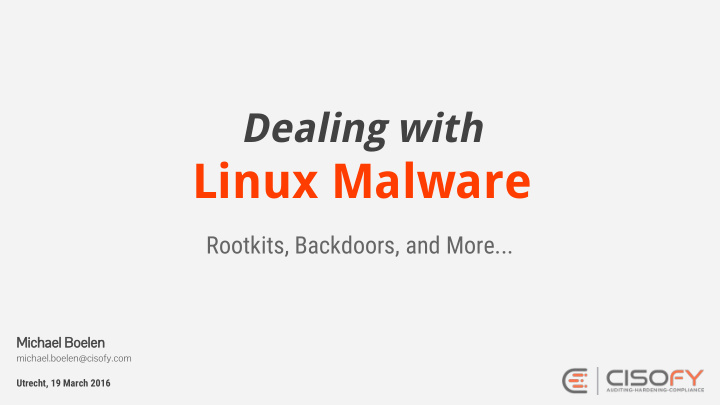



Dealing with Linux Malware Rootkits, Backdoors, and More... Michael Boelen michael.boelen@cisofy.com Utrecht, 19 March 2016
Agenda Today 1. How do “they” get in 2. Why? 3. Malware types 4. In-depth: rootkits 5. Defenses 2
Interactive ● Ask ● Share ● Presentation 3
Michael Boelen ● Security Tools ○ Rootkit Hunter (malware scan) ○ Lynis (security audit) ● 150+ blog posts ● Founder of CISOfy 4
How do “they” get in
Intrusions ● Simple passwords ● Vulnerabilities ● Weak configurations ● Clicking on attachments ● Open infected programs 6
Why?
Why? ● Spam ● Botnet 8
9
Types
Types ● Virus ● Worm ● Backdoor ● Dropper ● Rootkit 11
Rootkits 101
Rootkits ● (become | stay) root ● (software) kit 13
Rootkits ● Stealth ● Persistence ● Backdoor 14
How to be the best rootkit?
Hiding ★ In plain sight! /etc/sysconfig/… /tmp/mysql.sock /bin/audiocnf 16
Hiding ★★ Slightly advanced ● Rename processes ● Delete file from disk ● Backdoor binaries 17
Hiding ★★★ Advanced ● Kernel modules ● Change system calls ● Hidden passwords 18
Demo
Demo 20
Demo 21
Rootkit Hunter Detect the undetectable! 22
Challenges ● We can’t trust anything ● Even ourselves ● No guarantees 24
Continuous Game 25
Defense
Defenses At least ● Perform security scans ● Protect your data ● System hardening 27
Scanning » Scanners ● Viruses → ClamAV ● Backdoors → LMD ● Rootkits → Chkrootkit / rkhunter 28
Scanning » File Integrity ● Changes ● Powerful detection ● Noise AIDE / Samhain 29
System Hardening » Lynis ● Linux / UNIX ● Open source ● Shell ● Health scan 30
Conclusions
Conclusions ● Challenge: rootkits are hard to detect ● Prevent: system hardening ● Detect: recognize quickly, and act 32
Success! You finished this presentation
More Linux security? Presentations michaelboelen.com/presentations/ Follow ● Blog Linux Audit (linux-audit.com) ● Twitter @mboelen 34
35
Recommend
More recommend